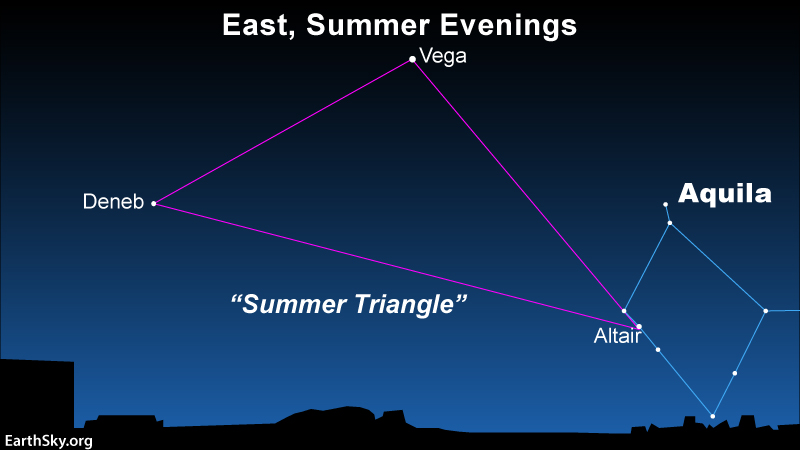Symbolism: Aquila the Eagle

Altair, in the constellation Aquila the Eagle, is one of 3 stars in the Summer Triangle. Photo Earth & Sky
Mythology: Aquila represents the eagle, which held Zeus’s/Jupiter’s thunderbolts in Greco-Roman mythology. Aquila is also associated with the eagle that kidnapped Ganymede, a son of one of the kings of Troy (associated with Aquarius), to Mount Olympus to serve as cup-bearer to the gods.
In another story, the eagle is found guarding the arrow of Eros (represented by the constellation Sagitta), which hit Zeus and made him love-struck. In yet another myth, Aquila represents Aphrodite disguised as an eagle, pretending to pursue Zeus in the form of a swan, so that Zeus’ love interest, the goddess Nemesis, would give him shelter. In the story, Zeus later placed the images of the eagle and the swan among the stars to commemorate the event.
The name of the brightest star in the constellation, Altair, is derived from the Arabic al-nasr al-ta’ir, which means “flying eagle” or “vulture.” Ptolemy called the star Aetus, which is Latin for “eagle.” Similarly, both Babylonians and Sumerians called Altair “the eagle star.”
In Hinduism, the constellation Aquila is identified with the half-eagle half-human deity Garuda.
In Japan Vega is sometimes called Tanabata (or Orihime), a celestial princess or goddess, who falls in love with a mortal, Kengyu (or Hikoboshi), represented by the star Altair.
When is it visible? The constellation Aquila, the eagle, is visible in the northern hemisphere from July through October.
How to find it? In the east after dark on these summer evenings, look near the horizon for Altair, the brightest star in the constellation Aquila the Eagle. This is the bottom star of the Summer Triangle; that is, it’s the last of these three bright stars to ascend over the horizon. It is located along the Milky Way.
History: Aquila was one of the 48 constellations described by the second-century astronomer Ptolemy. It had been earlier mentioned by Eudoxus in the fourth century BC and Aratus in the third century BC. Aquila contains the Glowing Eye Nebula (NGC 6751), which is a planetary nebula made famous when its image was chosen to commemorate the Hubble’s 10th anniversary.
Only eight of the stars have been officially approved by the International Astronomical Union (IAU), which leaves all of the rest of the Aquila constellation stars to be named as gifts at Name a Star.
